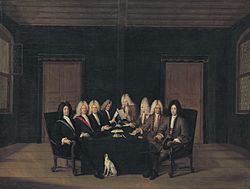Treaty of Baden (1714) facts for kids

The emissaries of the peace congress of Baden on 7 September 1714; Marshall Villars on the far left, Prince Eugene on the far right.
Johann Rudolf Huber, oil on canvas, 1714 |
|
| Context | End of the War of the Spanish Succession |
|---|---|
| Signed | 7 September 1714 |
| Location | |
| Negotiators |
|
| Parties | |
| Language | French |
The Treaty of Baden was a very important agreement signed on September 7, 1714. It officially ended the fighting between the Kingdom of France and the Holy Roman Empire. These two powerful groups had been at war for a long time. This war was called the War of the Spanish Succession.
The treaty was signed in a town called Baden, Switzerland. It helped complete other peace agreements like the Treaty of Utrecht and the Treaty of Rastatt.
Contents
What Was the War of the Spanish Succession?
The War of the Spanish Succession was a big European conflict. It lasted from 1701 to 1714. The war was fought over who would become the next king of Spain. Many countries were involved, including France and the Holy Roman Empire.
The Holy Roman Empire was a large group of lands in Central Europe. It was led by an emperor. The Kingdom of France was a powerful country in Western Europe.
Why Was the Treaty of Baden Needed?
The Treaty of Rastatt had already helped end some of the fighting. It made Emperor Charles VI of the Holy Roman Empire accept the Treaty of Utrecht. However, the peace between France and the Holy Roman Empire was not fully settled.
The Treaty of Baden fixed these remaining issues. It made sure that all parts of the War of the Spanish Succession were finally over.
Key Points of the Treaty
- France was allowed to keep control of Alsace and Landau. These were important areas.
- However, France had to give back the land east of the Rhine River to Austria. This area was called the Breisgau.
- Two important leaders, the prince-electors of Bavaria and Cologne, got their lands and positions back. They had lost them during the war.
- Emperor Charles VI kept the title of King of Spain. But this title did not give him any real power in Spain. King Philip V of Spain was the true ruler there.
Interesting Facts About the Treaty
The Treaty of Baden was the first international agreement ever signed in the Swiss Confederacy. This was a big moment for Switzerland.
During the peace talks, the countries involved also made a secret agreement. They decided to form a Catholic union. This union would help the Catholic areas in Switzerland. These areas had lost a battle two years earlier. This battle was called the Second War of Villmergen. The peace agreement from that war had changed power in Switzerland.
A local official named Caspar Joseph Dorer wrote down details about the treaty. He was an eyewitness to the peace conference. His writings help us understand what happened.
See also
 In Spanish: Tratado de Baden (1714) para niños
In Spanish: Tratado de Baden (1714) para niños

